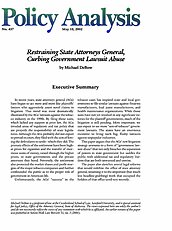Although the AGs probably did not expect to prevail in court, they filed with the aim of forcing the defendants to settle–which they did. The primary effects of the settlement have been higher prices for cigarettes and the transfer of enormous sums of money, raised through the higher prices, to state governments and the private attorneys they hired. Perversely, the settlement also protected the market shares and profit margins of the major tobacco companies and further confounded the public as to the proper role of government in American life.
Unfortunately, the AGs’ “success” in the tobacco cases has inspired state and local governments to file similar lawsuits against firearms manufacturers, lead paint manufacturers, and health maintenance organizations. While those suits have not yet resulted in any significant victories for the plaintiff governments, much of the litigation is still pending. More important, we can expect to see more “son-of-tobacco” government lawsuits. The states have an enormous incentive to bring such big, flashy lawsuits against unpopular industries.
This paper argues that the AGs’ new litigation strategy amounts to a form of “government lawsuit abuse” that not only breaches the separation of powers in state government but saddles the public with additional tax and regulatory burdens that are both unwanted and unwise.
The paper also sketches several legal reforms that would redefine the office of state attorney general, returning it to the important (but much less headline-grabbing) work that occupied the holders of that office until very recently.

